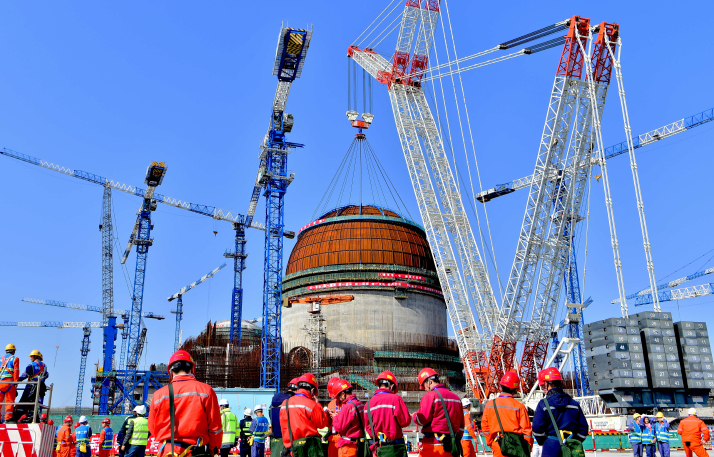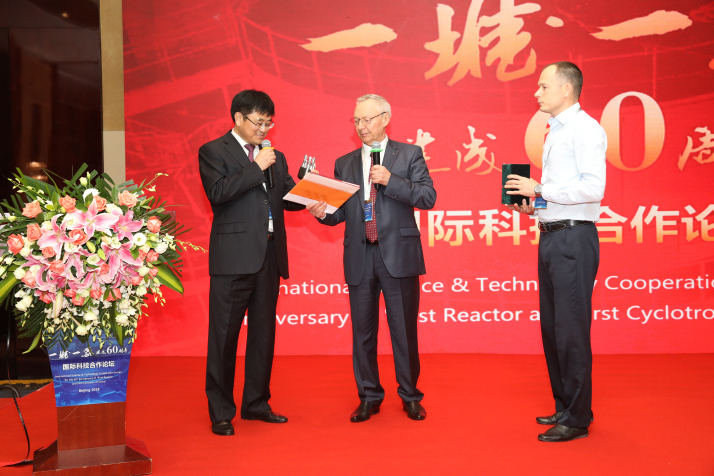| China |
| Nuclear Milestones | |
| China's nuclear industry shifts from military to civilian use over the last 40 years | |
|
|
 The reactor dome of the No. 6 nuclear power unit is installed on March 21 in southeast China's Fujian Province. Built by China National Nuclear Corp., it is China's second nuclear power unit using the Hualong One technology (XINHUA)
The year 2018 marks the 63rd anniversary of China's nuclear industry, which began in January 1955, when late leader Mao Zedong announced the Central Government's decision to develop atomic energy as a form of self-defense. In the last 40 years, the reform and opening-up policy was not only carried out in the economic sector, but also in this critical industry. "China's nuclear practitioners, riding the wave of reform and opening up, renovated the industry and shifted it to dual-use technology that has both civilian and military applications," said Yu Jianfeng, President of China National Nuclear Corp. (CNNC), which built the first nuclear plant on the Chinese mainland, at a press conference on the company's development in the past four decades on November 15 in Beijing. Starting point In 1958, the China Institute of Atomic Energy (CIAE), China's largest nuclear research arm, built the first experimental heavy water reactor and the first cyclotron, also known as the First Reactor and First Cyclotron (FRFC). "The FRFC played a crucial role in the invention of China's first atomic and hydrogen bombs and nuclear-powered submarine," Yu said. "The FRFC ushered in an era of atomic energy in China, driving its nuclear sector and leaving a splendid chapter in the history of China's nuclear technology development," said Wan Gang, head of CIAE, at the opening ceremony of an international forum on science and technology cooperation in Beijing on August 30. More than 200 Chinese and foreign experts—including Mikhail Chudakov, Deputy Director General of the International Atomic Energy Agency (IAEA) and senior executive with the China Atomic Energy Authority and CNNC—took part in the forum to exchange views on nuclear technology innovation. According to Wan, the reactor and cyclotron have been in operation for 49 and 26 years, respectively, resulting in more than 30 national and 100 provincial and ministerial level research and development awards. They were vital in isotope production and application, nuclear power generation, as well as neutron activation analysis and neutron scattering research. From military to civilian The Third Plenary Session of the 11th Central Committee of the Communist Party of China in 1978 marked the beginning of China's historic reform and opening-up journey. China's nuclear sector started to shift from single military application to multiple civilian uses. The effort kicked off with nuclear power generation. In December 1991, China's first 300,000-kilowatt nuclear power plant, the Qinshan Nuclear Power Plant, generated electricity and merged into the grid. The power plant, designed and built by CNNC, was a major breakthrough in the country's nuclear sector, turning China into the seventh country in the world capable of designing and building nuclear energy plants. In addition, it was a milestone marking the transition of China's nuclear industry from military application to civilian usage. Over the following decades, CNNC kept improving its nuclear power plants. In 2015, the ground was broken for the construction of the No.5 unit of CNNC's Fuqing Nuclear Power Plant in southeast China's Fujian Province, which is expected to go into operation by 2020. It is China's first demonstration nuclear power project using Hualong One technology, a domestically developed third-generation reactor design. By the end of 2017, CNNC had generated 717.5 billion kilowatt hours of electricity, reducing standard coal consumption by 287 million tons. This meant a reduction of 715.35 million tons of carbon dioxide emissions, equivalent to the carbon dioxide absorption of 1.96 million hectares of broad-leaved forest. Nuclear heating is another way to use the power for civilian purposes. In November 2017, CNNC unveiled Yanlong, a heating solution that harnesses heat generated by a small nuclear reactor. The pool-type low-temperature heating reactor operated safely for over 168 hours, heralding a new era of heating in China. The launch of Yanlong is the first step in CNNC's ambitious plan to boost nuclear heating in north China over the next few years. The company expects to get approval for the construction of a pilot nuclear-fired heating project by the end of 2018 and put it into commercial operation after 2020. "A 400-MW Yanlong is expected to be the source of indoor heating for a maximum area of 20 million square meters. According to these calculations, it can supply heating for nearly 500,000 residents, roughly the average population of a Chinese county," Ke Guotu, Chief Designer of the reactor, told Beijing Review. Medical care equipment production is another transformation direction, as CNNC continues to build medical centers in China, with 10 completed and 13 more under construction.  On August 30-31, an international forum on science and technology cooperation is held in Beijing to celebrate the 60 years of China's first nuclear reactor and cyclotron (ZHANG YANSHENG)
International cooperation The birth of China's nuclear industry was a result of international cooperation. The FRFC were built with the help of the Soviet Union. "They are a symbol of China-Russia friendship, evidence of China's openness and cooperation," Wan told Beijing Review. Moreover, the FRFC helped enable Chinese nuclear technology to go global, bridging Chinese nuclear institutes with more international organizations. In the past six decades, CIAE has teamed up with the IAEA and other international bodies, as well as 195 institutes in 32 countries and regions. A long-term mechanism for science and technology communication and cooperation was formed between CIAE and international organizations. In 2017, CIAE completed the Ghana MNSR LEU conversion project, delivering on a promise made by President Xi Jinping at the 2016 Nuclear Security Summit in Washington, D.C. to help Ghana secure nuclear safety and ensure nuclear non-proliferation in the world. One year later, CIAE exported the NDT electron linear accelerator, breaking into the overseas accelerator market for the first time. In the same year, CIAE helped upgrade the Algerian Birine reactor 30 years after building an Algerian heavy water research reactor. "In the past 60 years, the FRFC have underpinned the growth of both CIAE and China's nuclear industry. They also helped enhance international nuclear cooperation between China and other countries," said Wan. "China is the country with the fastest-growing nuclear power sector and the largest importer of nuclear electricity in the world," said Yu. On June 8, the biggest nuclear-power deal between China and Russia was hammered out on the eve of the 2018 Shanghai Cooperation Organization Summit in Qingdao. The total contract value amounted to 20 billion yuan ($2.88 billion). Today, Hualong One has become the new face of China's nuclear industry. In September 2016, the China General Nuclear Power Corp. and French power giant EDF Group inked deals with the British Government to build three projects in the UK, one of which is expected to use Hualong One technology. The second phase of the assessment of the project has already been completed. In addition, more and more Made in China nuclear medical care products, such as radioimmunoassay kits, are being exported to many countries such as South Korea, the Philippines and Bangladesh. Copyedited by Rebeca Toledo Comments to linan@bjreview.com |
|
||||||||||||||||||||||||||||
|
